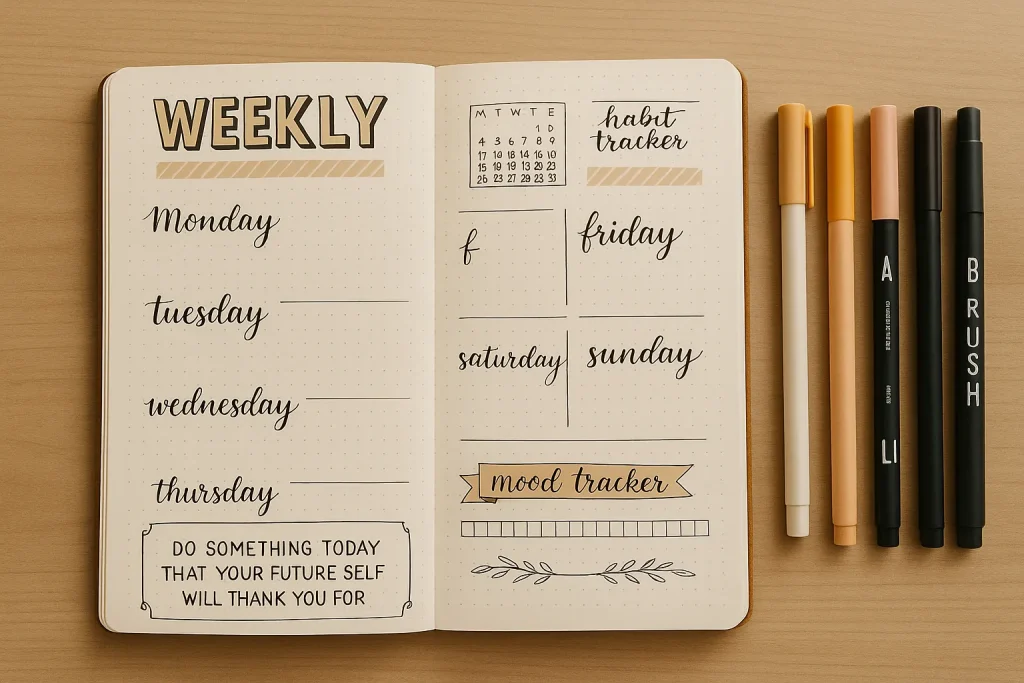
Neatness isn’t just about aesthetics—it brings organization, clarity, and joy to your daily planning.
If you’ve ever opened Instagram or Pinterest and marveled at those picture-perfect pages, you’re not alone.
The truth? Anyone can learn how to write neat in a bullet journal with intentional practice, the right tools, and some helpful tips.
Let’s dive into the best practices and strategies for achieving neat, structured, and visually pleasing handwriting in your bullet journal.
Table of Contents
Why Neatness in Bullet Journals Matters
- Clarity: Neat writing makes future reference easier.
- Motivation: Clean pages encourage regular use and boost your confidence.
- Creativity: Allows layouts, doodles, and trackers to shine.
- Personal Satisfaction: There’s a unique fulfillment in seeing your effort reflected in the pages.
Choosing the Right Tools
Neat bullet journaling starts with the right supplies. You don’t need fancy materials, but specific tools make a difference:
Pens and Markers
- Fineliners
- Brush Pens: Ideal for how to write bullet journal calligraphy, headers, and embellishments.
- Gel Pens: Pilot G2 or Uni-ball Signo provide a smooth, skip-free writing experience.
Paper Quality
- Thickness: Opt for journals with at least 80gsm paper to prevent ghosting and bleeding.
- Texture: Smooth paper helps for neater lines, even in a bullet journal on lined paper.
Notebook Types
- Dot Grid: The favorite for those learning how to layout bullet journal pages with flexibility.
- Grid or Lined: Easier alignment for beginners—great for those wondering how to start a bullet journal for beginners.
- Unruled Journals: Require more control, ideal once you’ve practiced.
Cultivating Neat Handwriting: Basic Principles
1. Slow Down
Writing deliberately lets your hand form letters with care—critical when learning how to improve your handwriting bullet journal.
2. Maintain a Relaxed Grip
A light grip ensures smoother, more consistent strokes in your bullet journal.
3. Focus on Uniformity
Consistent letter size, spacing, and slant are key—foundation of how to write quotes in a bullet journal or headers.
4. Practice Letterforms
Use tracing sheets or study Instagram layouts for ideas of what you’d like to emulate in your own bullet journal doodles how to or headers.
Layout Techniques for Neatness
Learning how to layout bullet journal spreads enhances both beauty and functionality.
Spacing & Margins
Use rulers, washi tape, or pencil guides for even margins.
Guidelines and Boxes
Utilize dot grids for sectioning out how to draw a calendar in a bullet journal or designing a tv show tracker bullet journal.
Dividing Sections
Section logs and trackers with washi tape: a creative way to learn how to use washi tape in bullet journal spreads.
Lettering Styles for Bullet Journals
Print vs. Cursive
For most, print style offers neatness and is perfect when learning how to bullet journal when you’re not artistic.
Faux Calligraphy
Use faux calligraphy to master how to write bullet journal calligraphy with everyday pens.
Block Letters and Outlines
Perfect for headers, monthly titles, or if you’re learning how to draw bullet journal headers.
Practicing Neatness: Effective Drills
Regular practice gets you closer to having that clean look, especially if you’re exploring how to keep yourself motivated to follow bullet journal routines.
- Alphabet Practice: Great for preparing custom headers if you’re learning how to start a minimalist bullet journal.
- Spacing and Line Drills
- Header Practice: Trace examples or test what works best in how to make a key for a bullet journal alphabet.
Strategies for Everyday Log Neatness
Even on your busiest days, these strategies will help if you’re learning how to use bullet journal effectively:
- Simple bullets: Stick with consistent checkboxes or symbols if you’re doing how to use bullet journal for work.
- Avoid clutter: Leave space between task lines and try not to write to the page’s edge.
- Daily Check-Ins: A few minutes every evening keeps you grounded—it’s part of how to maintain a bullet journal.
Fixing Mistakes & Preventing Smudges
Even for digital methods like how to create a bullet journal in OneNote or how to make a digital bullet journal, mistakes happen!
Correcting Mistakes
Use correction tape, washi tape, or stickers. For creative fix ideas, try how to decorate first page of project bullet journal with an error you turned into art!
Preventing Smudges
Lefties and right-handed users benefit from different strategies. When writing how to make a bullet journal index or detailed habit trackers, always let ink dry!
Inspirational Layouts & Style Ideas
If you’re stuck, find new layouts by exploring:
- Monotone Minimalism: Great if you’re seeking how to start a simple bullet journal.
- Color coding: Helpful for those thinking about how to use bullet journal for project management or weight loss.
- Doodles and Borders: Learn how to draw banners for bullet journal or doodle micron icons!
Building a Sustainable, Neat Journaling Routine
If you’ve ever wondered how to make your own bullet journal routine, it starts small!
Tips for Consistency
- Designate weekly time for layouts—the secret behind how to use bullet journal app, printables, or even how to make bullet journals on Android.
- Use this space for meeting notes, goal setting, or learn how to use a bullet journal for weight loss.
Keep a workspace ready, whether you’re using a physical notebook or learning how to create a digital bullet journal with Evernote or how to use Trello as a bullet journal.
Conclusion
Neat handwriting isn’t about being perfect—it’s about developing your own rhythm and making your bullet journal uniquely yours. With intentional practice, the right tools, and a curious mind, you can turn even your smartphone notes into a creative journal (yes, even how to make a bullet journal on phone or in Keynote!).
Whether you want to:
- Decorate your bullet journal cover
- Combine bullet planner with personal journal
- Or simply learn how to bullet journal for the month
…it’s within reach.
Take your ideas—no matter how messy—and turn them into a layout that works for YOU. That’s the key to understanding how to put your ideas in bullet journal form. Whether for school, goals, or passion projects—every bullet starts with a single dot.
Happy journaling!
Let me know if you’d like a downloadable version (PDF or DOCX), or a variation optimized for SEO articles or blog posts!

